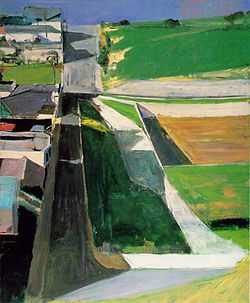Bay Area Figurative Movement


The Bay Area Figurative Movement (also known as the Bay Area Figurative School, Bay Area Figurative Art, Bay Area Figuration, and similar variations) was a mid-20th Century art movement made up of a group of artists in the San Francisco Bay Area who abandoned working in the prevailing style of Abstract Expressionism in favor of a return to figuration in painting during the 1950s and onward into the 1960s.
Spanning two decades, this art movement is often broken down into three groups, or generations: the First Generation, the Bridge Generation, and the Second Generation.
Many of the "First Generation" artists in this movement were avid fans of Abstract Expressionism, and worked in that manner, until several of them abandoned non-objective painting in favor of working with the figure. Among these First Generation Bay Area Figurative School artists were: David Park, Richard Diebenkorn, Elmer Bischoff, Wayne Thiebaud, and James Weeks.
The "Bridge Generation" included the artists: Nathan Oliveira, Theophilus Brown, Paul John Wonner, Roland Petersen, John Hultberg, and Frank Lobdell.[1]
Many "Second Generation" artists of this movement studied under the First Generation artists, or were late starters. Among these Second Generation artists were: Bruce McGaw, Henry Villierme, Joan Brown, Manuel Neri, and Robert Qualters.
Many San Francisco area schools and institutions were important to the development and refinement of this art movement, including: the San Francisco Art Institute, the California College of Arts and Crafts, and University of California, Berkeley.
References
Sources
- Jones, Caroline A. (1990) Bay Area Figurative Art: 1950-1965, Berkeley, CA: University of California Press, ISBN 0-520-06842-4
- Landauer, Susan (2000) The Lighter Side of Bay Area Figuration, San Jose, CA: Kemper Museum of Contemporary Art, ISBN 1-891246-03-8
External links
- "Bay Area Figurative Movements", John Natsoulas Gallery, 2006.
- "The San Francisco Rebellion" by Edward M. Gomez, Time, February 5, 1990.
- "Review/Art: San Francisco Revolution in Style Recalled in a Traveling Exhibition" by Roberta Smith, New York Times, August 29, 1990.
- "The Lighter Side of Bay Area Figuration", San Jose Museum of Art, September 3–November 26, 2000.